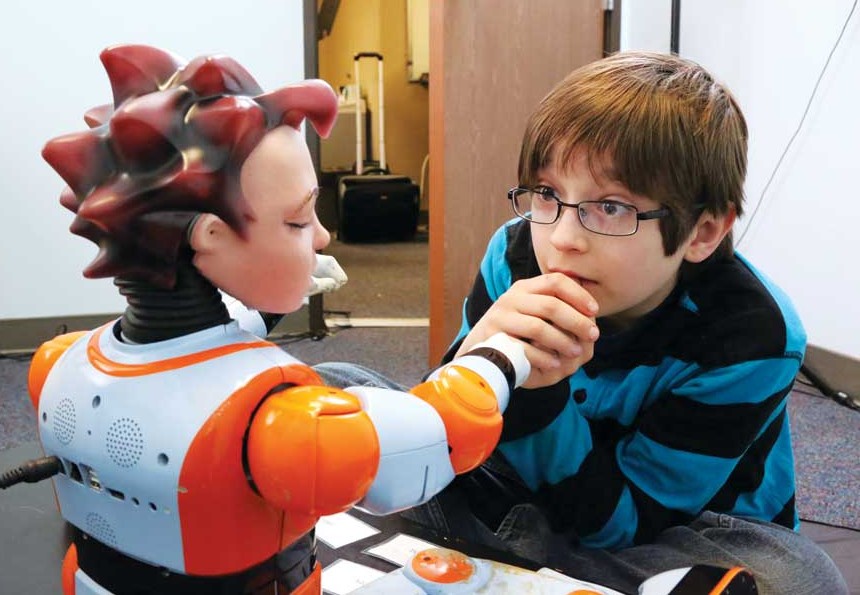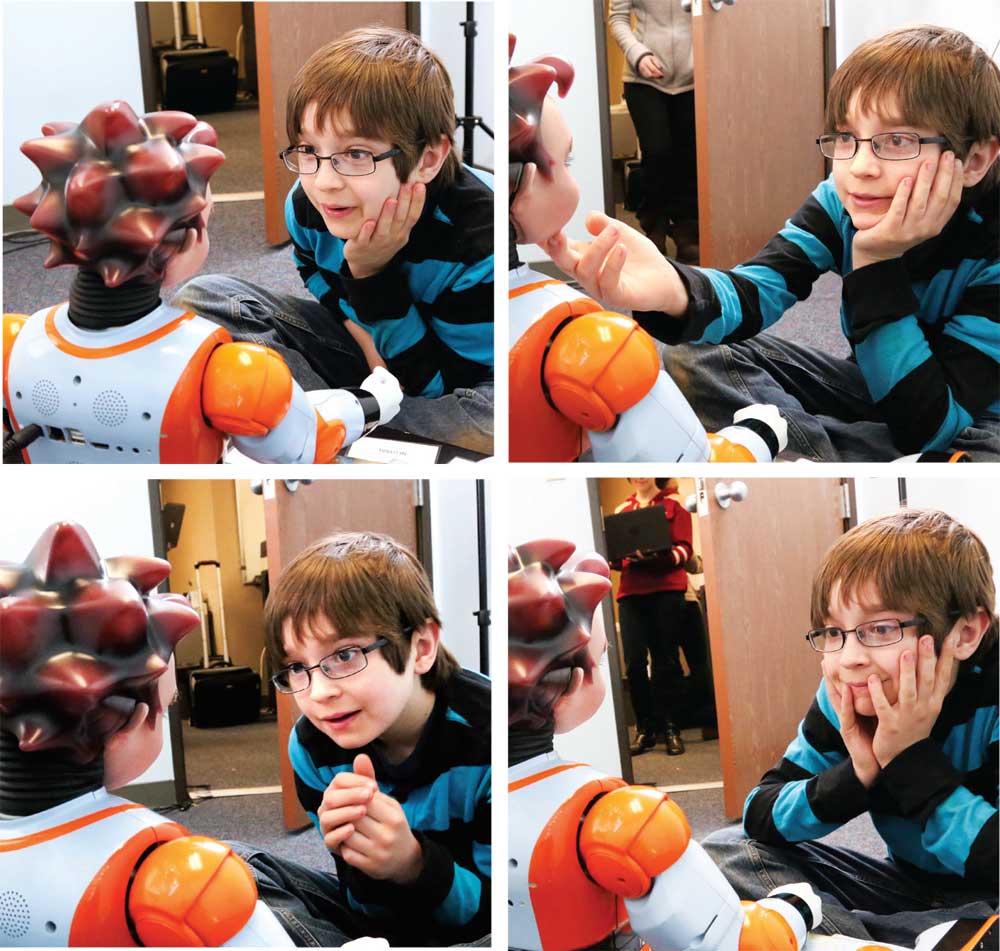
Some participants in the humanoid robot study at DU have shown improvements in emotional skills and affection, which are both typically difficult for people with autism. Gabe loves interacting with the robots, particularly Zeno.
Gabe, 12, is loud and talks a lot. He likes to read, especially Harry Potter. He is attentive and takes all mainstream classes. He’s extremely curious; for example, he likes to open up the compartments of printers and examine how they work. He has poor vision. Empathy does not make sense to him and he has no friends at school. Luke is his best friend.
Luke, 11, barely talks and reads far below grade level. He doesn’t focus on anything except for what’s right in front of him. He can build anything from his imagination out of Legos and creates freehand drawings. He has spectacular vision. He takes special education classes, except for band. Although he doesn’t talk, he has many friends in his class. Their time together is filled with lots of high-fives and other nonverbal communication.
“We both have autism, but our autism is different,” Gabe says, loudly and almost robotically.
Their younger sister, Ellie, 5, shows autistic tendencies, and their dad, Fred, thinks he may have autism as well. Although the Bourque family members may get diagnosed as being on the broad spectrum of autism, each is very distinct.
According to the U.S. Centers for Disease Control and Prevention, one in 88 children has autism, a brain development disorder. The rate is four to five times more common among boys than girls.
A mildly affected person might seem merely quirky and lead a relatively typical life. A severely affected person might be unable to speak or care for himself. Early and intensive intervention can make big differences in a child’s development and outcome.

Gabe Bourque watches the social robot NAO dance the Macarena, one of its many programmed skills. NAO is controlled by a researcher (middle) in the other room where psychology student Sophie Silver (left) and Gabe’s dad, Fred, observe.
New therapies are developing to help children with autism. At the University of Denver, a faculty-student research team is conducting a study with humanoid robots designed to improve recognition of facial expressions and eye gaze.
The robots play social games and ask questions while cameras record the children’s eye gaze. The robots reward kids for completing tasks. The robots are designed to be an additional tool for therapists or classrooms with children who have autism.
“Kids with autism really don’t like to interact with strangers and human interaction usually is very overwhelming because of the flood of sensory input,” says Mohammad Mahoor, assistant professor of electrical and computer engineering, who leads the study. “We use a robot as an assistive tool because kids with autism really love to interact with toys and objects.”
The program has two robots: NAO, a cute social robot that can walk, dance and play, and Zeno, a sedentary robot with a silicon face and realistic eyes that makes different expressions. Zeno is designed to detect emotions during interactions with humans in a realistic way, which may help children with autism recognize emotions.
The research team has completed three protocols with 70 participants, including Luke and Gabe, who were in the most recent protocol. They participated every other week for 2 hours over the course of six months.
On a recent day at the lab, Gabe was enthralled when NAO danced the Macarena. “That was great!” he cheered at the end, and the research team laughed. Luke didn’t pay any attention and played with his Legos. He usually only participates if he’s rewarded with breaks to watch clips from his favorite movies

Gabe interacts with Zeno, a humanoid robot with a silicon face and realistic eyes that express many facial expressions. Zeno is designed to detect emotions during interactions with humans in a realistic way, which may help children with autism recognize emotions.
“We adjust the study and programming of the robots for every kid because each one is so unique,” says Sophie Silver, a psychology major working on the study.
Results are as diverse as the autism spectrum. Some kids do not want to play with the robots at all; others love it. The study team may reduce the age range (now 7 to 17) because teenagers have shown less interest in the robots than younger children.
 Temple Grandin, an activist for people with autism, can see how the robots are a good way for kids to get interested in something, but says they still need to interact with real people. Grandin has become the symbol of exceeding beyond the difficulties of a disorder. She is an animal science professor at Colorado State University, best-selling author and the subject of an award-winning movie.
Temple Grandin, an activist for people with autism, can see how the robots are a good way for kids to get interested in something, but says they still need to interact with real people. Grandin has become the symbol of exceeding beyond the difficulties of a disorder. She is an animal science professor at Colorado State University, best-selling author and the subject of an award-winning movie.
Social interaction has been difficult for much of Grandin’s life, but her mother never allowed her to be a recluse. As a young girl, Grandin was required to be the hostess at her mother’s parties, which she did not like, but eventually got easier with time. Then in high school the only time she wasn’t bullied was when she was participating in the electronics lab, horseback riding and building model rockets.
Grandin says social interactions based on shared interests offer a way for people with autism to interact more comfortably.
“People are always looking for the magic solution to a lot of things, but many require a lot of management,” she says, explaining there isn’t a quick way for kids with autism to become comfortable socially and emotionally.
Fred Bourque can’t confirm the robots alone have made a significant difference for his sons, but in addition to their other interventions he’s noticed some change. “They’re getting helpful training. Maybe they’re not getting fixed in their brains, but they’re learning how to cope with the rest of us because really they’re in their own world,” he says.

Some participants in the humanoid robot study at DU have shown improvements in emotional skills and affection, which are both typically difficult for people with autism. Gabe loves interacting with the robots, particularly Zeno.



I’m so proud of gabe, now he is a great robot creator and i’m so happy that he could cure is autism.
Thank ZENO e MOHAMMAD
You can see more of Mohammad Mahoor’s research in action here: